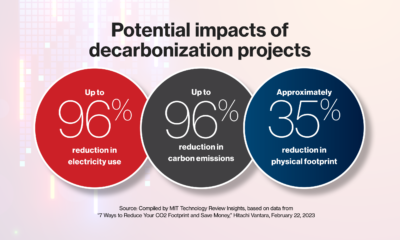Politics
Mobility Data Unlocks Opportunities in Emerging-Market Megacities
Published
3 years agoon
By
Drew Simpson
Governments can use public transport data to inform policymaking. Commuters benefit from real-time data on traffic or public-transport status. Yet, the biggest—and largely overlooked—use for mobile data could be for businesses themselves.
Infrastructure planning firms, research organizations, and banks use cutting-edge data sources to help make cities smarter. For investors, mobility data plays a role as a useful indicator of economic trends. More widely, all businesses benefit from understanding how their customers move, and where they travel every day. But what’s even better is finding the next set of customers that will help grow your business.
Mobility Data Unlocks Opportunities in Emerging-Market Megacities
Innovative mapping and data-gathering technologies reveal previously unseen patterns in people’s movements, particularly in emerging markets, where data production starts from a much lower baseline. This information is helping firms make better decisions on how and where to invest.
For any consumer-facing firm, mobility data can unlock a new view into potential customers, including the over 2 billion people in emerging-market megacities who rely entirely on public transport.
Innovation Brings New Data Sources
Traditional mobility data comes from point-in-time measurements such as traffic counts or public-transport ridership estimates. Expensive and time-consuming to collect, these older tools leave governments largely blind to the dynamism of the mobility ground truth in their cities. The methods are also of limited use to investors looking at market trends, or looking for new opportunities to build out real estate and infrastructure along transport thoroughfares.
We can now do much better. GPS tracking from mobile phones is one example, cutting across transport modes to tell us where people walk, bike, drive, or ride. Smarter traffic lights can serve as information sources while also giving pedestrians the time they need to cross the street. Many companies are working to create platforms that integrate new and traditional data sources to build a comprehensive model of the entire city.
Better Data for Smarter Cities
At the highest level, mobility data tells us where people are going and when. But it can also tell us where people want to go, but can’t.
In other words, we can now quickly see where there is a mismatch between what cities offer and what citizens want. Businesses can find opportunities in those gaps.
Planning firms and research
Take infrastructure planning firms, research organizations, and banks, which all form part of the tapestry of organizations that help make and implement urban planning decisions.
Their influence comes largely through advice for planning and research firms, which improves with better data use. For example, improved survey technology also allows consulting and planning firms to collect statistically significant samples of origin-destination data—telling us not just which public transport routes are heavily used, but where the passengers actually want to go.
Using GPS mobile phone data
INRIX, a transport data firm, pulled in individual GPS mobile phone data to understand the impact of pedestrianization programs on mobility during the COVID-19 pandemic. Importantly, the data goes beyond anything that is publicly available. For the good data that leads to good advice, the value far outweighs the cost.
Banks using mobility data
Banks are using data to prioritize mobility investments. The World Bank, for example, worked with a team in Kenya to identify crash hotspots (blogsdotworldbankdotorg) in the Nairobi road network. The analysis is helping prioritize investments with the Bank’s financing.
Financing transport infrastructure investments
When financing transport infrastructure investments, banks can now account for the entire mobility landscape. For example, the World Bank contracted my firm, WhereIsMyTransport, to provide comprehensive public transport network data for seven African cities. The Bank used this data to inform its investment evaluations for bus, rail, and other urban planning considerations across the continent.
Using a central source of reliable data
In each of these cities, the effort was the first time that the organization had benefited from a central source of comprehensive and reliable public transport network data, including the flexible and privately run vehicles that make up the vast majority of the network. In most emerging-market cities, more than two-thirds of public transport services operate in this way, without fixed timetables or fares, and with varying oversight from government entities.
Ten years ago, collecting data on independently operated public transport outside the sphere of government-run services would have been impossible (or at least prohibitively expensive). Now, with data-gathering software built for the purpose, it’s scalable to every city in the world.
Mobility Data Means Big Business
Aggregated mobility data give investors valuable economic clues. For example, throughout the COVID-19 pandemic, Google and Apple have provided summary mobility reports that have helped inform policy but have also been crucial for investors.
Economics research firms.
Economics research firms now view information on people’s movements as an integral source of “alternative data” that they gather and sell to hedge funds and other investors. For example, Bloomberg notes that mobility data can be “a direct reflection of economic activity and… provides insights into the direction of the economy.”
Granular mobility data can tip off businesses.
On the other end of the spectrum, granular mobility data can tip off businesses about where their customers go or where their next customers are. Just as governments want to know what type of street reforms attract people, companies are looking to invest in the types of areas that tend to prosper. They also want to invest in places where people are already traveling but aren’t yet well served.
A simple heuristic for placing your business to reach consumers: find the roads or public transport that move people between home and work. Indeed, research shows many companies do this already. For example, a study from the Netherlands showed that when firms move, they typically choose locations near roads or public transport.
Helpful transport links on a map.
Looking at transport links on a map seems to be a fairly old-school way to locate a business, far removed from the cutting-edge recommendations that ReadWrite readers look for. Instead, the innovation comes from going a level deeper, looking at individual movements daily, and looking at places where even a map is proprietary.
92% of the largest lower-middle-income cities lack a complete map of their public transport network, suggesting large gaps in mobility data more broadly. But, particularly with newly available datasets in emerging economies, we now have comprehensive information on how people move in the world’s largest, fastest-growing cities. While getting your hands on that data can come with a cost, doing so gives a leg up over other firms.
Direct to the customer e-commerce.
Reaching people in emerging-market megacities is one of the few fast-growing global markets where there has been relatively little serious competition from heavyweight developed-world organizations.
Although that is now changing, with investments flowing in from telecoms to direct-to-consumer e-commerce. Traditionally, businesses tend to be local, as international players are deterred by information barriers and the perception that these markets are complex and unpredictable. Nevertheless, the scale argument is easily answered: a Brookings Institution study of the world’s largest cities found that 80 percent of the top 60 performers came from emerging markets.
The information barriers are quickly breaking down.
Traditionally, supply chains in emerging-market cities are hyperlocal by necessity, since shops and wholesalers need to be on the ground to respond to demand. As a result, companies must sell through several layers of distributors to finally reach consumers. Each layer adds costs, decreasing the market’s attractiveness.
That is no longer the case. With city-level datasets, businesses can play on equal footing, knowing where their customers go each day, how they get to work, and which shopping centers they stop at on the way.
Showing the Way Forward
New sources of mobility data are improving our cities and bringing new opportunities for businesses. Especially in emerging markets, now is the time to put that information to work.
Image Credit: martin pechy; pexels; thank you!
Devin de Vries
CEO and co-founder
Devin de Vries is the CEO and co-founder of WhereIsMyTransport – a mobility
technology company that develops products to improve the public transport
experience in emerging-market megacities, and delivers data services that
inform industry leading clients.
You may like
-


Sustainability starts with the data center
-


Meta is giving researchers more access to Facebook and Instagram data
-


The Download: are we alone, and private military data for sale
-


It’s shockingly easy to buy sensitive data about US military personnel
-


The Download: military personnel data for sale, and AI watermarking
-


This new data poisoning tool lets artists fight back against generative AI
Politics
Fintech Kennek raises $12.5M seed round to digitize lending
Published
6 months agoon
10/11/2023By
Drew Simpson
London-based fintech startup Kennek has raised $12.5 million in seed funding to expand its lending operating system.
According to an Oct. 10 tech.eu report, the round was led by HV Capital and included participation from Dutch Founders Fund, AlbionVC, FFVC, Plug & Play Ventures, and Syndicate One. Kennek offers software-as-a-service tools to help non-bank lenders streamline their operations using open banking, open finance, and payments.
The platform aims to automate time-consuming manual tasks and consolidate fragmented data to simplify lending. Xavier De Pauw, founder of Kennek said:
“Until kennek, lenders had to devote countless hours to menial operational tasks and deal with jumbled and hard-coded data – which makes every other part of lending a headache. As former lenders ourselves, we lived and breathed these frustrations, and built kennek to make them a thing of the past.”
The company said the latest funding round was oversubscribed and closed quickly despite the challenging fundraising environment. The new capital will be used to expand Kennek’s engineering team and strengthen its market position in the UK while exploring expansion into other European markets. Barbod Namini, Partner at lead investor HV Capital, commented on the investment:
“Kennek has developed an ambitious and genuinely unique proposition which we think can be the foundation of the entire alternative lending space. […] It is a complicated market and a solution that brings together all information and stakeholders onto a single platform is highly compelling for both lenders & the ecosystem as a whole.”
The fintech lending space has grown rapidly in recent years, but many lenders still rely on legacy systems and manual processes that limit efficiency and scalability. Kennek aims to leverage open banking and data integration to provide lenders with a more streamlined, automated lending experience.
The seed funding will allow the London-based startup to continue developing its platform and expanding its team to meet demand from non-bank lenders looking to digitize operations. Kennek’s focus on the UK and Europe also comes amid rising adoption of open banking and open finance in the regions.
Featured Image Credit: Photo from Kennek.io; Thank you!
Radek Zielinski
Radek Zielinski is an experienced technology and financial journalist with a passion for cybersecurity and futurology.
Politics
Fortune 500’s race for generative AI breakthroughs
Published
6 months agoon
10/11/2023By
Drew Simpson
As excitement around generative AI grows, Fortune 500 companies, including Goldman Sachs, are carefully examining the possible applications of this technology. A recent survey of U.S. executives indicated that 60% believe generative AI will substantially impact their businesses in the long term. However, they anticipate a one to two-year timeframe before implementing their initial solutions. This optimism stems from the potential of generative AI to revolutionize various aspects of businesses, from enhancing customer experiences to optimizing internal processes. In the short term, companies will likely focus on pilot projects and experimentation, gradually integrating generative AI into their operations as they witness its positive influence on efficiency and profitability.
Goldman Sachs’ Cautious Approach to Implementing Generative AI
In a recent interview, Goldman Sachs CIO Marco Argenti revealed that the firm has not yet implemented any generative AI use cases. Instead, the company focuses on experimentation and setting high standards before adopting the technology. Argenti recognized the desire for outcomes in areas like developer and operational efficiency but emphasized ensuring precision before putting experimental AI use cases into production.
According to Argenti, striking the right balance between driving innovation and maintaining accuracy is crucial for successfully integrating generative AI within the firm. Goldman Sachs intends to continue exploring this emerging technology’s potential benefits and applications while diligently assessing risks to ensure it meets the company’s stringent quality standards.
One possible application for Goldman Sachs is in software development, where the company has observed a 20-40% productivity increase during its trials. The goal is for 1,000 developers to utilize generative AI tools by year’s end. However, Argenti emphasized that a well-defined expectation of return on investment is necessary before fully integrating generative AI into production.
To achieve this, the company plans to implement a systematic and strategic approach to adopting generative AI, ensuring that it complements and enhances the skills of its developers. Additionally, Goldman Sachs intends to evaluate the long-term impact of generative AI on their software development processes and the overall quality of the applications being developed.
Goldman Sachs’ approach to AI implementation goes beyond merely executing models. The firm has created a platform encompassing technical, legal, and compliance assessments to filter out improper content and keep track of all interactions. This comprehensive system ensures seamless integration of artificial intelligence in operations while adhering to regulatory standards and maintaining client confidentiality. Moreover, the platform continuously improves and adapts its algorithms, allowing Goldman Sachs to stay at the forefront of technology and offer its clients the most efficient and secure services.
Featured Image Credit: Photo by Google DeepMind; Pexels; Thank you!
Deanna Ritchie
Managing Editor at ReadWrite
Deanna is the Managing Editor at ReadWrite. Previously she worked as the Editor in Chief for Startup Grind and has over 20+ years of experience in content management and content development.
Politics
UK seizes web3 opportunity simplifying crypto regulations
Published
6 months agoon
10/10/2023By
Drew Simpson
As Web3 companies increasingly consider leaving the United States due to regulatory ambiguity, the United Kingdom must simplify its cryptocurrency regulations to attract these businesses. The conservative think tank Policy Exchange recently released a report detailing ten suggestions for improving Web3 regulation in the country. Among the recommendations are reducing liability for token holders in decentralized autonomous organizations (DAOs) and encouraging the Financial Conduct Authority (FCA) to adopt alternative Know Your Customer (KYC) methodologies, such as digital identities and blockchain analytics tools. These suggestions aim to position the UK as a hub for Web3 innovation and attract blockchain-based businesses looking for a more conducive regulatory environment.
Streamlining Cryptocurrency Regulations for Innovation
To make it easier for emerging Web3 companies to navigate existing legal frameworks and contribute to the UK’s digital economy growth, the government must streamline cryptocurrency regulations and adopt forward-looking approaches. By making the regulatory landscape clear and straightforward, the UK can create an environment that fosters innovation, growth, and competitiveness in the global fintech industry.
The Policy Exchange report also recommends not weakening self-hosted wallets or treating proof-of-stake (PoS) services as financial services. This approach aims to protect the fundamental principles of decentralization and user autonomy while strongly emphasizing security and regulatory compliance. By doing so, the UK can nurture an environment that encourages innovation and the continued growth of blockchain technology.
Despite recent strict measures by UK authorities, such as His Majesty’s Treasury and the FCA, toward the digital assets sector, the proposed changes in the Policy Exchange report strive to make the UK a more attractive location for Web3 enterprises. By adopting these suggestions, the UK can demonstrate its commitment to fostering innovation in the rapidly evolving blockchain and cryptocurrency industries while ensuring a robust and transparent regulatory environment.
The ongoing uncertainty surrounding cryptocurrency regulations in various countries has prompted Web3 companies to explore alternative jurisdictions with more precise legal frameworks. As the United States grapples with regulatory ambiguity, the United Kingdom can position itself as a hub for Web3 innovation by simplifying and streamlining its cryptocurrency regulations.
Featured Image Credit: Photo by Jonathan Borba; Pexels; Thank you!
Deanna Ritchie
Managing Editor at ReadWrite
Deanna is the Managing Editor at ReadWrite. Previously she worked as the Editor in Chief for Startup Grind and has over 20+ years of experience in content management and content development.
